by David J. Watkins
Beginning Astrophotography - DSO's Deep Space Objects
1) Astrophotography 101 2) Wide Angle 3) The Moon 4) Large Nebula 5) DSO's 6) Planets 7) The Sun
Imaging DSO's:
The Deep Space Objects discussed here include Galaxies, Planetary Nebula, and Star Clusters.
Planetary Nebula:
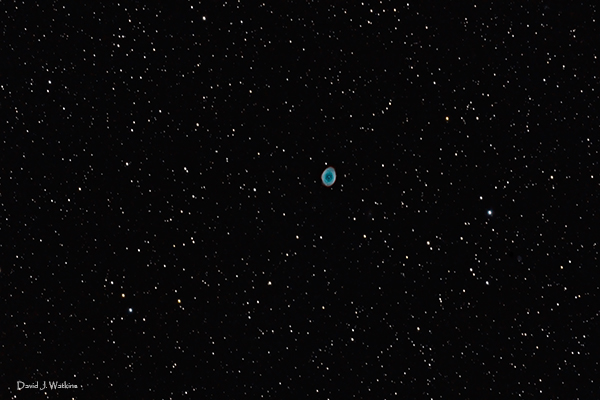
Planetary Nebula are reminants of dying stars. The gases have spread out over an area
many times the size of the original star. Planetary nebula tend to be brighter than emission
nebula, but are extremely tiny as compared to emission nebula. A long focal length telescope and a
tracking mount are necessary to capture planetary nebula. A DSLR can be used, but just as with the
emission nebula, you will lose much of the red spectrum due to the IR filter on the DSLR. You can shoot
with a modified DSLR or the Canon D60a, but I find planetary nebula are best captured with a dedicated astrophotography
CMOS or CCD camera. ZWO makes a line of grayscale and color CMOS cameras that give exceptional results on planetary nebula.
The Ring Nebula (Messier Object M57) - Canon 5DMarkII (un-modified, notice the lack of red spectrum) ISO1600 10 images 90 seconds each. Celestron EdgeHD 8 inch
scope, NOT autoguided.
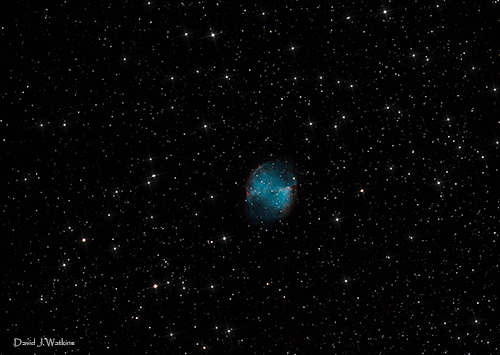
The Dumbbell Nebula (Messier Object M27) - Canon 5DMarkII (un-modified) ISO1600 31 images 30 seconds each. Celestron
EdgeHD 8 inch scope, NOT autoguided.
Since most planetary nebula are bright the required exposure time is much less than for other DSO's.
The two planetary nebula examples on this page were exposed for only about 15 minutes each. The reason that
several images were used instead of one 15 minute exposure is that I was not using an autoguider for my
tracking mount. Autoguiding is required for very long exposures because even the best tracking mounts
are not perfect.
If your polar alignment for the mount is not perfect the stars will also drift. An autoguiding system consists
of separate telescope or an off-axis guider, and a separate camera usually connected to a laptop or tablet PC.
A bright guide star is chosen and the camera takes images of the guide star frequently and if the guide star begins
to drift by a fraction of a pixel, the software will send a correction signal to the mount to re-center the star.
Autoguiding is discussed in the section Aquiring Astro Images.
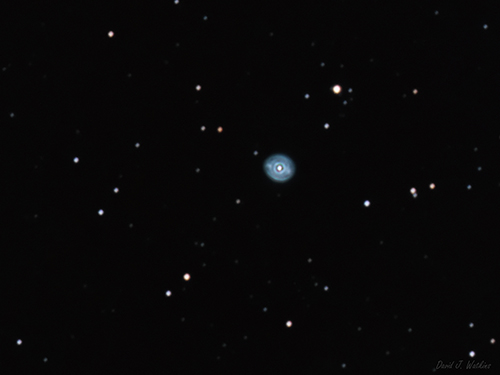
Most Planetary Nebula are very small. The Ring Nebula and Dumbell Nebula are exceptionally large when it comes
to planetary nebula. This is an image of NGC6826 or the Blinking Planentary Nebula. It is roughly 1/3
the size of the Ring Nebula!. You can see what a DSLR reveals for the Ring Nebula at the top of the page.
One of the issues with a DSLR and tiny planeatary nebula, is the large pixel and sensor size. A dedicated CCD or
CMOS camera with smaller
pixels and sensor size will yield a larger image (smaller field of view) revealing more detail.
This image was taken on the Celestron EdgeHD 8 inch with a 6 MP dedicated astrophotography color CMOS camera -
ZWO ASI178MC. It consists of 90 15 second images with a gain of 1. I used the program
Nebulosity to capture the sequence of images and PHD2 for auto-guiding. The core of NGC6826 is very bright,
so I limited each exposure to 15 seconds to not blow out the core. The image was processed using PixInsight. Note
that when you narrow down the field of view and enlarge the image, auto-guiding becomes necessary even for a 15 second image.
Galaxies:
Galaxies vary in size. The size, for the most part, depends on how far away the galaxy is from Earth. The Andromeda Galaxy (Messier Object M31) is the largest visible galaxy. The Andromeda Galaxy will appear approximately 6 times the size of the full moon in a perfect dark sky! Andromeda is about 2 million light years from earth, it is the closest of the larger galaxies to our own galaxy. An example of small but close galaxies are the 14 satellite galaxies orbiting the Andromeda galaxy. Two of the satellite galaxies are clearly visible in the photo below.
The Andromeda galaxy is so large that it can be captured with a camera, telephoto lens (200mm or greater or a small telescope), and tracking mount. In a dark sky, Andromeda will be visible with the naked eye, but in most areas it will require at the very least a one hour exposure.
The next largest galaxy would be the Triangulum galaxy (Messier Object M33), it is about 3 million light years away from earth. It can be captured with a camera, super telephoto lens (500mm or greater or a small telescope), and tracking mount. Plan for at least an hours worth of exposures.
The rest of the galaxies will tend to be small and while they can be captured with a camera and super telephoto lens they will appear very small in the frame. A medium to long focal length telescope and tracking mount is better suited to capturing those galaxies.
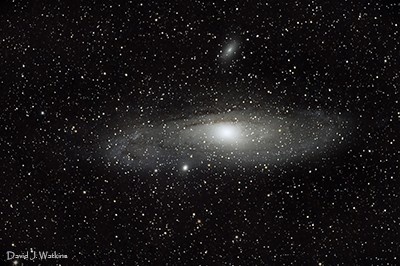
Andromeda Galaxy (Messier Object M31) - Canon 5DMarkII (un-modified), 600mm lens f/4.5, ISO400, 20 three minute exposures NOT
autoguided.
Also visible are M32 located above Andromeda and M110 located just on the lower edge of Andromeda. These
are satellite galaxies to Andromeda.
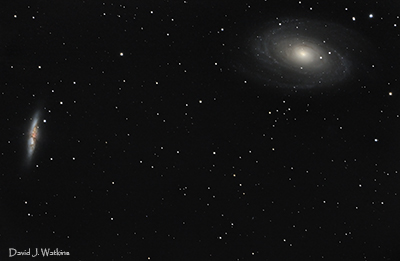
Bodes Galaxy and Cigar Galaxy (Messier Object M81 and M82) - Canon 5DMarkII (un-modified), ISO1600, 26 two minute exposures.
Celestron EdgeHD 8 inch telescope NOT autoguided. M81 and M82 are about 12 million light years from
earth.
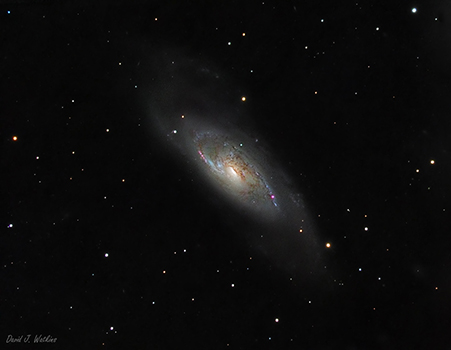
Messier 106 Galaxy - Celestron EdgeHD 8 Inch with 0.7x reducer. ATIK 460EX monochrome 6MP cooled CCD camera. This image consists of close to
7 hours of images. The color was achived by shooting 3 separate sequences through colored filters, a red, a green, and a blue filter.
Each filtered image consists of 8 five minute exposures. That is two hours just for the color. For the luminance channel, I used a Lumicon
Deepsky light pollution filter and imaged right from my driveway in a small city. Again I used 5 minute exposures for close to 5 hours.
With the DSLR, I could never achive the colors in the red spectrum, especially the small blobs of hydrogen gas in the spiral arms. You can even begin to see the
very faint outer spiral arms. I probably need another 4 hours of luminance to bring up the outer faint arms.
I used the program Nebulosity to control the camera to capture the images. PHD2 was used for auto-guiding.
Star Clusters:
Star clusters are dense groupings of stars located within our galaxy. There are two basic types of star clusters; globular clusters and open clusters. Globular clusters are very densly packed generally globe shaped groupings of stars. They may contain as many as several hundred thousand stars. Open clusters are much less dense than globular clusters and may contain only a few hundred stars.
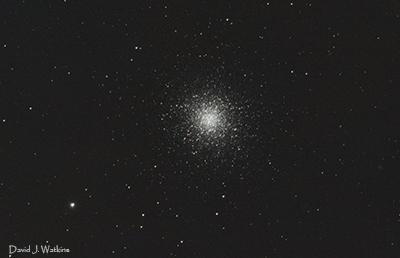
Great Cluster In Hercules (Messier Object M13) - Canon 5DMarkII (un-modified), ISO1600, 4 two minute exposures NOT
autoguided. Celestron EdgeHD 8 inch telescope. This image was cropped from the original.
M13 is a globular cluster.
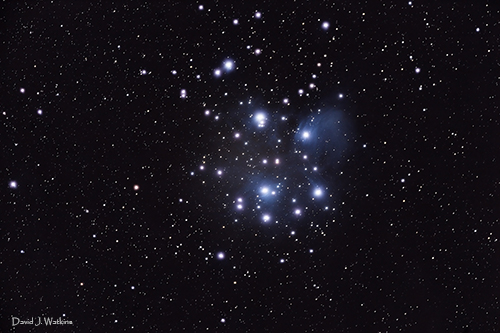
Pleiades Cluster (Messier Object M45) - Canon 5DMarkII (un-modified), 600mm lens f/4.0, ISO200, 8 three minute exposures NOT
autoguided.
M45 is an open cluster with a reflection nebula.
DSO's and stacking:
Since digital camera sensors will not handle extremely long exposures, astrophotographers will capture many shorter exposures and use software to stack or add the photos together to create a single exposure that is equivalent to the total time of all the stacked images. The shorter exposures can be as short as 30 seconds or as long as 20 minutes. Stacking images also reduces random noise artifacts that typically affect dark images. Stacking involves aquiring more images than just the images of the nebula. Typically dark frames, bias frames, and flat frames are aquired. This will be discussed in greater detail in the Astro Imaging and Astro Image Processing sections.
Focus:
Again, I cannot stress enough how important perfect focus is!
Review Of Recommended Equipment:
- Equatorial GEM Tracking Mount
- Autoguider system for mount
- Medium (1000mm) to Long (2000mm or greater) focal length telescope for planetary nebula and globular star clusters.
- Super Telephoto lens for large galaxies (Andromeda, Triangulum) and open star clusters.
- DSLR modified or un-modified, Grayscale CCD/CMOS with LRGB (Luminance, Red, Green, Blue) filters, or Color CCD/CMOS.
- Software for stacking images
Equipment you might be able to get away with:
- 200mm telephoto lens for large galaxies (Andromeda, Triangulum) and open star clusters.
- For DSLR images you can get away with no autoguider for exposures of 30 seconds. With perfect polar alignment 2 minute exposures. On CCD/CMOS cameras with smaller pixels, you will have to autoguide.
1) Astrophotography 101 2) Wide Angle 3) The Moon 4) Large Nebula 5) DSO's 6) Planets 7) The Sun